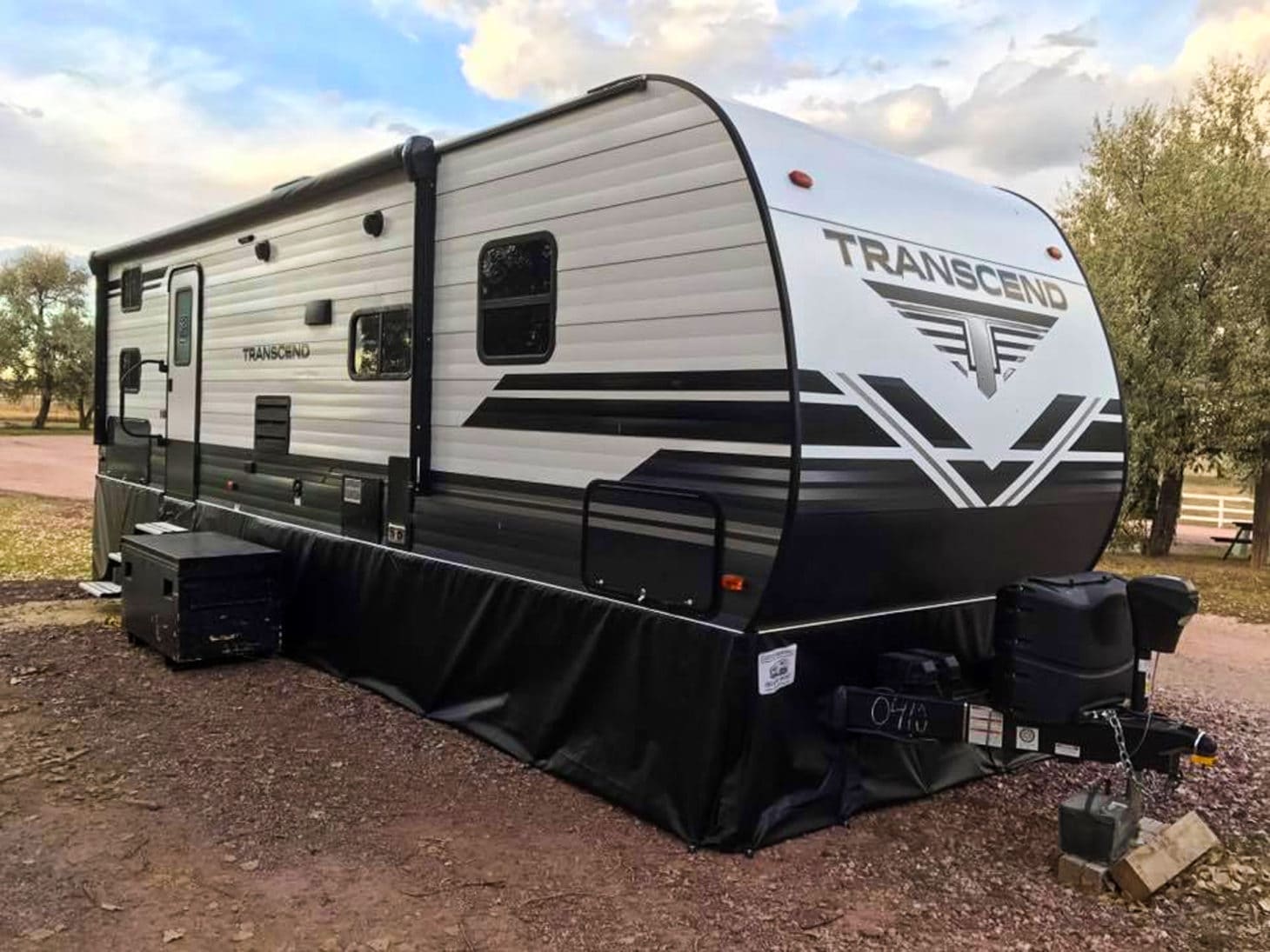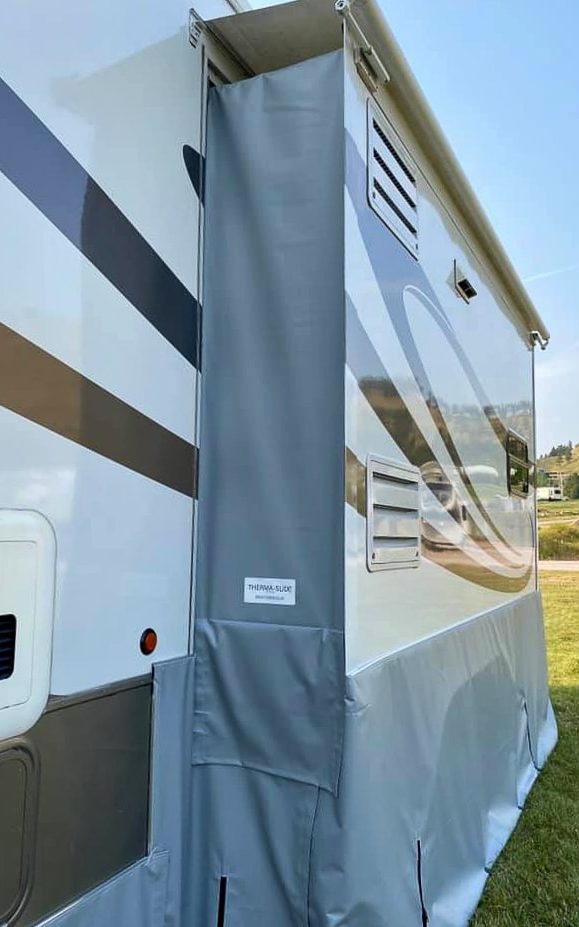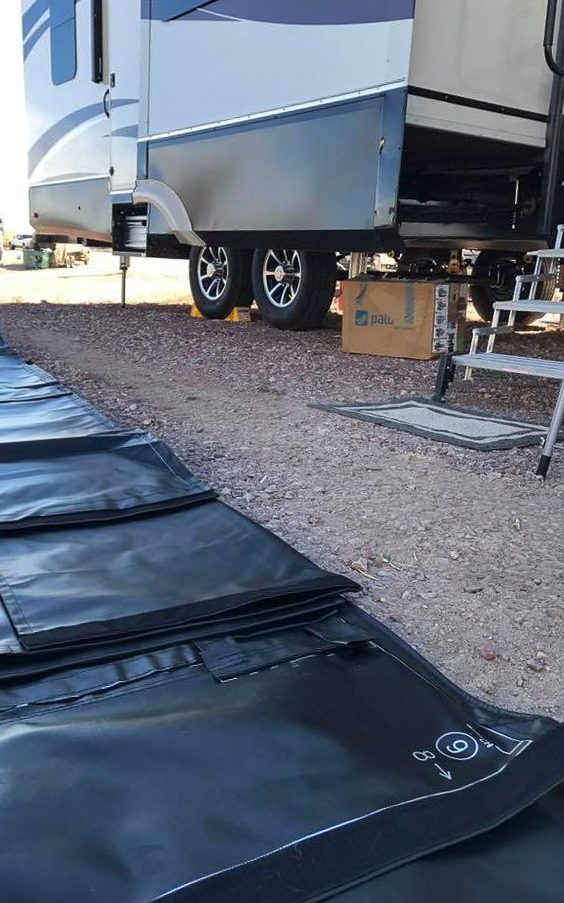Most RVs are not designed to be used in extremely cold weather. Some RVs come equipped with an “arctic package” option, but there are no guarantees it will protect your RVs plumbing system when temperatures plummet below freezing. So, the question is: If you camp in freezing temperatures, will skirting the RV help prevent its plumbing system from freezing? Continue reading for some helpful tips and information about RV skirting.
What is RV skirting?
RV skirting is a method of preventing freezing air and wind from circulating under the RV and potentially freezing components of its plumbing system. The concept of skirting is to place some type of protective barrier from the ground to the bottom of the RV—it needs to completely enclose the RV to work. This allows you to control the temperature under the RV and prevent the plumbing system from freezing. When you contain the air under the RV and provide a source of heat, it exponentially increases the odds against freezing.
Why should you use RV skirting?
If you live full-time in your RV, or if you enjoy taking cold weather RV trips and camping in a region susceptible to below freezing temperatures, skirting your RV is a wise precaution. It takes a little work to skirt your RV, but the end result is peace of mind that the RV plumbing system will survive the freezing temperatures while enabling you to still use running water.

Does RV skirting work?
Let me give you an example: I own a rental property in North Carolina where it rarely freezes, but it can freeze. The property has a well to provide water to the house. The pump and tank for the well are both located at ground level. I built walls with a roof around the pump and tank to prevent direct exposure to freezing temperatures. Then I added a small light inside that can be turned on or off. When freezing temperatures are in the forecast, I just turn the light on to create heat in the enclosed space and prevent the pump and tank from freezing.
This is the same concept as skirting your RV. You enclose the bottom of the RV to assist in controlling the temperature and provide a source of heat to prevent the plumbing from freezing.
Do you need RV skirting if you have an enclosed underbelly?
Every RV owner needs to know where the plumbing is located on their RV. The plumbing can be below floor level, above floor level, or a combination of both. Some RVs have an insulated enclosed underbelly with heat, while others only use a thin material to enclose the underbelly. An enclosed underbelly helps, but in below-freezing temperatures, any plumbing below the floor can freeze without a heat source. So, skirting the RV can assist by containing the area under the RV, and then controlling the temperature to prevent freezing.
What is the best RV skirting for winter?
Keep in mind that the job of skirting the RV is to block cold air from circulating under it. With that said, you want a skirting system that completely encloses the underside of the RV. If there are sections in the skirting that still allow cold air to get under the RV, it defeats the purpose. There are numerous types of RV skirting available, but you should look for the following in a skirting solution:
- High-quality material
- Completely encloses the underside of the RV
- Easy to install
- Easy to remove
- Easy to store
A good skirting system should do all of the above. The bottom line is to block the cold air from getting under the RV, so you can control the temperature and prevent freezing.
How much does RV skirting cost?
There are variables that affect pricing for RV skirting: the size of the RV, the quality of the skirting material, and whether it’s self-installed or custom-designed and professionally installed. The cheaper the skirting is, the more prone it is to problems. It will likely be more difficult to install and remove, it won’t be made from high-quality material, and it might do a poor job of completely enclosing the underside of the RV. A custom-designed skirting kit will cost more, but it eliminates many of the problems associated with skirting the RV.
If you live in your RV full-time and temperatures are below freezing, I recommend a higher-end skirting system, which typically costs a few thousand dollars. It will last longer and do a better job enclosing the RV. On the other hand, if you just plan to camp a week or two in below-freezing temperatures, a good middle-of-the-road priced RV skirting kit should suffice. Depending on the material used, this can cost anywhere from a few hundred dollars for a small camper to a thousand dollars for larger rigs.
What is fabric RV skirting?
Fabric skirting includes products and materials like vinyl, insulated vinyl, vinyl with a sewn-in backing, canvas, or a homemade tarp skirt. While you don’t have to use an insulated product, you want a fabric that will hold up when exposed to harsh environments.

What is wood RV skirting?
Some RV owners get creative when it comes to RV skirting. You can cut sheets of plywood to custom fit the underside of your RV. It will help block cold air, but it involves a significant investment in time and materials. After the plywood is cut to fit, you need an effective method to secure it to the RV, which can involve building additional wood framing. Plywood skirting is more of a permanent or semi-permanent skirting solution, as it’s heavy and not easy or convenient to remove and store in the RV.
What is foam board RV skirting?
Another homemade RV skirting solution is the use of foam boards. The foam acts as an insulator: It’s lightweight, inexpensive, and it can be shaped and cut to fit your RV. Similar to plywood, you need a method of securing the foam to the RV after the panels are cut.
Is EZ Snap RV skirting a quality product?
EZ Snap skirting is a quality product and is easy for anybody (regardless of your skill level) to install. Many people like it because it doesn’t require drilling. The EZ Snap website has a convenient calculator to determine what size skirting you need. It lists the average price for the most commonly ordered kit, 80 feet, at $814. The fabric is rated for negative 40-degree temperatures, and you can choose a color to closely match your RV.
Can you make your own RV skirting?
Some RV owners design and construct their own RV skirting products. In addition to plywood and foam boards, I’ve seen RV owners use other products like picket fencing and blue tarps. No matter what product or material you use to skirt your RV, it all comes down to how well it blocks cold air from getting under the RV.
How do you attach skirting to an RV?
There are several methods for attaching skirting to your RV. The most common method is using a snap or twist-lock fastener. You install one end of the snap on the RV and the other end is attached to the fabric. Some attachments require drilling, while others—like EZ Snap—attach to the RV using adhesive tape. Other types of skirting use a channel system attached to the RV where the fabric panels slide directly into the channels.
No matter the method, the bottom of the skirting must be secured to the ground to prevent air from getting under the skirting. Most RV skirting solutions use loops at the bottom to stake it to the ground, while others are weighted.


Can I install RV skirting myself?
There are plenty of DIY skirting kits to choose from, and with a few basic skills and tools, you can install it yourself. If for any reason you are not comfortable drilling or installing the skirting fasteners on your RV, talk to a local RV dealer or camping store about installing it for you.
How long does it take to install RV skirting?
It really depends on what type of skirting system you have and how well you know your RV. Expect a minimum of a few hours with a helper and an easy to install kit, but skirting your RV can be more than a day’s work if you’re self-constructing.
Installing the skirting is simply a matter of properly snapping or sliding the panels into place. If you already know where the skirting panels go on the RV, you can lay them out to match the corresponding fasteners on the RV. However, if it’s your first time installing RV skirting, the process will take a bit longer.
If you’re using a service professional, expect the skirting process to take a few days for proper measurements and installation. You can go with a company that specializes in RV skirting or an RV mobile repair professional. Those that do siding work or mobile home skirting may offer RV skirting services as well.
Do you still have to winterize your RV if you use RV skirting?
It depends. There are two major goals for skirting your RV: to block out cold air and wind by containing the underside of your RV and to prevent any part of the plumbing system below the floor from freezing and getting damaged. Skirting can solve the problem below floor level, but the area above floor level must be addressed too. If you keep your RV heated inside at all times during freezing temperatures, you do not need to winterize the plumbing system. But if for any reason your source of heat fails, the plumbing can freeze and be damaged if it’s not properly winterized.
Skirting your RV during freezing weather is a tried and true method of protecting the plumbing under your RV. Anyone living or camping in their RV for extended periods of time during freezing weather can benefit from the effort and expense required to skirt the RV.
